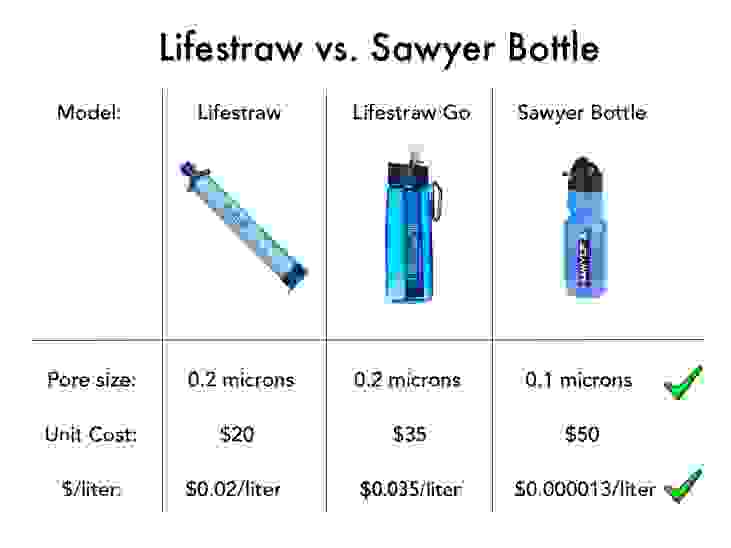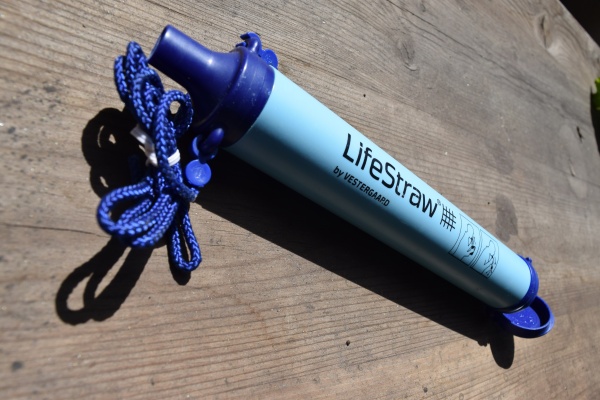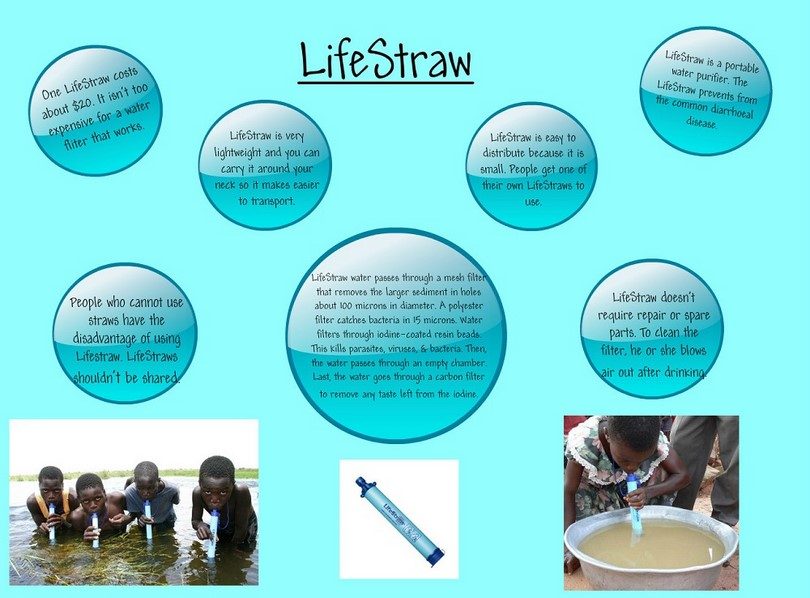Introduction
When it comes to portable water filters, LifeStraw is a brand that often comes to mind. It’s compact, easy to use, and can be a lifesaver when you’re out in the wilderness or facing a natural disaster. However, no product is without its drawbacks. In this article, we’ll explore some of the potential downsides of using a LifeStraw and what you should consider before making a purchase.
LifeStraw is a water purification system designed to filter out almost all waterborne contaminants, bacteria, parasites, and viruses from water sources. It is lightweight, portable, and easy to use, making it an ideal camping or hiking accessory. However, there are some disadvantages to using LifeStraw that users should be aware of before using it.
One of the main disadvantages of LifeStraw is that it does not filter out heavy metals or chemicals from water sources. This means that if you are using LifeStraw to drink from a contaminated water source, you could still be exposed to harmful contaminants. Additionally, LifeStraw only filters out a maximum of 1000 liters of water before it needs to be replaced, so it is not suitable for long-term use.
Additionally, some users have found that the LifeStraw can be difficult to suck water through if the water source is not moving quickly enough. This can make it difficult to use in certain situations, such as if you are trying to drink from a stagnant pond. Overall, LifeStraw is a useful tool for short-term use in emergency situations or when camping or hiking in remote areas with no clean water sources nearby.

What is LifeStraw?
LifeStraw is a water filter designed to be used by one person for up to one year. It removes 99.9999% of waterborne bacteria and 99.9% of waterborne protozoan parasites, according to the manufacturer’s website.
One major advantage of LifeStraw is that it requires no electricity to operate, which makes it ideal for use in developing countries or during power outages. It is also lightweight and portable, making it easy to take with you on camping trips or hikes.
However, there are also some disadvantages to using LifeStraw. One is that it can only filter up to 4,000 liters of water, so you would need to purchase multiple straws if you wanted to use it for an extended period of time. Additionally, LifeStraw does not remove viruses from water, so it is not suitable for use in areas where waterborne diseases are a concern.
How does LifeStraw filter work?
Have you ever been on a camping or hiking trip and wondered how you were going to get clean drinking water? Traditional water filtration systems can be bulky, heavy, and expensive. Thankfully, LifeStraw provides a simple, lightweight, and effective solution to this problem. But how does the LifeStraw filter work? Let’s dive in and find out. First, let’s start with some background information. LifeStraw is a portable water filter that was invented in 2005 by a Swiss company called Vestergaard. The LifeStraw filter was designed to provide safe water for drinking to people in developing countries who did not have access to clean water sources. Since then, the LifeStraw filter has become popular among hikers, campers, and travelers who want a reliable way to purify water while on the go.
So, how does the LifeStraw filter work? The LifeStraw filter uses a hollow fiber membrane to filter out bacteria, parasites, and other contaminants from water. When you suck water through the LifeStraw, the water passes through the hollow fibers, which are smaller in diameter than human hair. As the water passes through the fibers, contaminants are trapped and filtered out, leaving clean water for drinking.
One of the key benefits of the LifeStraw filter is its ability to remove bacteria and parasites without the use of chemicals or electricity. This makes it a great option for people who are camping or hiking in remote areas where access to clean water sources may be limited. The LifeStraw filter is also lightweight and compact, making it easy to pack and carry with you on your adventures.
The LifeStraw filter has been tested by independent third-party laboratories and meets US EPA drinking water standards. The filter is capable of removing 99.9999% of waterborne bacteria and 99.9% of waterborne protozoan parasites. This means that you can trust the LifeStraw filter to provide safe water for drinking, even in the most challenging environments.
In addition to the classic LifeStraw filter, there are also other options available, such as the LifeStraw Go water bottle and the LifeStraw Family water purifier. The LifeStraw Go water bottle combines the convenience of a water bottle with the effectiveness of the LifeStraw filter, allowing you to fill up your bottle from any water source and drink clean water on the go. The LifeStraw Family water purifier is designed for use at home or in a community setting, providing safe water for drinking for up to 18,000 liters.
When not to use a LifeStraw?
When it comes to outdoor adventures or emergency situations, the LifeStraw is a popular water filtration device that many people turn to for clean water for drinking. However, there are certain situations where using a LifeStraw may not be the best option. In this article, we’ll explore some of the scenarios where you should avoid using a LifeStraw.
1. Water with Chemical Contaminants
The LifeStraw is designed to filter out bacteria and parasites from water sources, but it does not remove chemical contaminants. If you are unsure about the water source or suspect that it may contain chemicals such as pesticides or industrial waste, it’s best to avoid using a LifeStraw. Chemical contaminants can cause serious health problems, and LifeStraw is not equipped to handle them.
2. Water with High Turbidity
Turbidity refers to the cloudiness of water caused by suspended particles. Although the LifeStraw can filter out bacteria and parasites, it may not be effective in filtering out particles that cause turbidity. If the water source appears cloudy or murky, it’s best to avoid using a LifeStraw as it may not be effective in providing clean drinking water.
3. Water with Unusual Odors or Tastes
If the water source has a strange odor or taste, it’s best to avoid using a LifeStraw. While the LifeStraw can filter out bacteria and parasites, it may not remove the taste or odor of chemicals or pollutants in the water. Consuming water with an unusual taste or odor may cause stomach upset or other health problems.
4. Freezing Temperatures
The LifeStraw is not designed to be used in freezing temperatures. If the temperature drops below freezing, the LifeStraw may freeze and become damaged or ineffective. It’s important to keep the LifeStraw at room temperature and avoid using it in extremely cold conditions.
5. Long-Term Use
The LifeStraw is designed for short-term use and may not be effective in filtering large amounts of water over an extended period of time. If you plan to use the LifeStraw for longer periods, it’s best to consider other water filtration options that are designed for more frequent or extensive use.

What water can you not drink with a LifeStraw?
Water is a vital resource that we need to survive. However, not all water sources are safe for drinking, especially in areas where access to clean water is limited. That’s where the LifeStraw comes in handy. The LifeStraw is a popular water filter that has been designed to remove contaminants and pathogens from water, making it safe for drinking. But what water can you not drink with a LifeStraw? In this section, we will explore the different types of water that LifeStraw cannot filter.
Saltwater
The LifeStraw cannot filter saltwater. Saltwater has a high salt concentration that can damage the filter’s membrane, rendering it useless. If you find yourself stranded on a beach with no access to fresh water, do not use the LifeStraw to drink saltwater. Instead, focus on finding alternative sources of freshwater.
Chemical-contaminated water
The LifeStraw is not effective in removing chemical contaminants from water. Chemicals such as pesticides, fertilizers, and other industrial pollutants can seep into water sources, making the water unsafe for drinking. If you suspect that the water source is contaminated with chemicals, do not use the LifeStraw. Instead, look for alternative sources of water or seek professional help.
Turpid water
The LifeStraw cannot filter turbid water. Turbid water is water that appears cloudy or muddy due to suspended particles. The filter’s membrane can get clogged, reducing the flow rate and effectiveness of the LifeStraw. If the water source is turbid, try to remove the suspended particles by allowing the water to settle or use a cloth to filter it before using the LifeStraw.
Extreme temperatures
The LifeStraw is designed to work within a specific temperature range. Extreme temperatures, either too hot or too cold, can damage the filter’s membrane, rendering it ineffective. If you find yourself in a location with extreme temperatures, do not use the LifeStraw. Instead, try to find alternative sources of water.
Lifestraw review: What to do if you need a serious purification?
When it comes to outdoor adventures, there’s nothing quite like exploring the great outdoors. Whether you’re hiking, camping, or backpacking, being in nature is a great way to disconnect from the hustle and bustle of everyday life. However, with all the beauty of nature also comes a variety of potential hazards, one of which is contaminated water sources. According to the World Health Organization, around 2.2 billion people worldwide lack access to safe drinking water, which is why it’s crucial to have a reliable water purifier when you’re out in the wild. Enter the Lifestraw, a portable water filter that has been praised by hikers, campers, and outdoor enthusiasts around the world for its ability to provide clean water in even the most rugged environments. In this review, we’ll take a closer look at the Lifestraw and what makes it the go-to choice for those who need serious purification.
First off, what is the Lifestraw? It’s a simple but effective device that uses advanced filtration technology to remove bacteria, parasites, and microplastics from any freshwater source. It’s highly portable, with a lightweight design that makes it easy to pack in your backpack or survival kit. With the Lifestraw, you can drink directly from rivers, lakes, and streams without worrying about getting sick.
So, what sets the Lifestraw apart from other water filters on the market? For one, it’s incredibly easy to use. You simply immerse the straw into the water source and sip the purified water through the mouthpiece. It doesn’t require any batteries, chemicals, or electrical power, which means it’s completely self-sufficient and can be used anywhere in the world.
The Lifestraw also boasts a high filtration capacity, with the ability to filter up to 4,000 liters of water throughout its lifespan. That’s enough to provide a single user with safe drinking water for up to three years! And, because it doesn’t require any replacement parts, it’s a cost-effective option for those who regularly spend time in the great outdoors.
Another thing that sets the Lifestraw apart is its durability. It’s made from high-quality materials that are designed to withstand even the most rugged environments. It’s also been tested to meet rigorous standards for water filtration, ensuring that you can rely on it to keep you safe and healthy no matter where you are.
Of course, no product is perfect, and Lifestraw is no exception. One potential drawback is that it doesn’t remove chemicals or heavy metals from water sources. This means that if you’re in an area with high levels of toxins in the water, Lifestraw may not be able to provide the level of filtration you need. Additionally, while it’s great for personal use, it may not be practical for larger groups or families.

What Are the Disadvantages of LifeStraw?
Water is essential for human survival, and access to clean drinking water is a basic human right. Unfortunately, not everyone has access to safe drinking water. Waterborne diseases can be deadly, and millions of people around the world suffer from illnesses and deaths caused by contaminated water. One solution to this problem is LifeStraw, a portable water filtration device that has become popular in recent years. While LifeStraw has many advantages, such as being lightweight, affordable, and easy to use, it also has some disadvantages that users should be aware of. In this section, we will explore some of the disadvantages of LifeStraw.
1. Drinking Water Through LifeStraw Is Somewhat Tricky
One of the main disadvantages of LifeStraw is that it can be somewhat tricky to drink water through this device. The LifeStraw works by using a series of filters to remove impurities and contaminants from the water. While this filtration process is effective, it also makes drinking water through the device more difficult. Users need to suck on the device with a certain amount of force to draw water through the filters. This can be challenging for some individuals, particularly those with respiratory issues.
2. LifeStraw Can’t Filter All of The Contaminants
While LifeStraw is effective at filtering out many harmful contaminants, it is not able to filter out all of them. For example, LifeStraw cannot remove chemical contaminants such as pesticides, herbicides, and other industrial chemicals. It also cannot filter out viruses, which are smaller than bacteria and can cause diseases like hepatitis A, norovirus, and rotavirus.
3. Water Filtered Through LifeStraw Can’t Be Used for Cooking
The LifeStraw is designed to filter water for drinking purposes only. This means that water filtered through the LifeStraw cannot be used for cooking, washing dishes, or other household activities. If you need water for these purposes, you will need to find an alternative source of clean water.
4. Sensitive to Freezing Temperatures
The LifeStraw is sensitive to freezing temperatures. If the filter is exposed to freezing temperatures, the filter can crack and become ineffective. This means that if you plan to use the LifeStraw in cold weather, you will need to take extra precautions to prevent the filter from freezing.
5. It Works Only with A Water Resource or Container
The LifeStraw is designed to work with a water source or container. This means that if you are in an area where there is no water source, such as a desert or a high-altitude mountain, the LifeStraw will not be effective. You will need to find an alternative source of water or bring your own water supply.
6. Lack of Versatility
The LifeStraw is designed to filter water only for personal use. It is not versatile enough to filter water for a group of people or for larger volumes of water. This means that if you are traveling in a group, you will need to bring multiple LifeStraws or find an alternative water filtration system.
7. Personal LifeStraw Can’t Be Shared
While the LifeStraw is designed for personal use, it cannot be shared with others. This means that if you are traveling with others who do not have access to clean water, they will need to find their own water filtration system.
8. No Way to Transport Filtered Water
Finally, LifeStraw does not provide a way to transport filtered water. Once you have filtered the water, you will need to find a way to carry it with you. This can be a challenge if you are traveling in areas where there is no access to clean water.
LifeStraw is an effective and affordable water filtration system that has helped many people around the world gain access to clean drinking water. However, it is important to be aware of the disadvantages of the LifeStraw before using it. If you are traveling to an area where there is no access to clean water, you will need to bring multiple LifeStraws or find an alternative water filtration system. Additionally, the LifeStraw is not effective at filtering out all contaminants, and water filtered through the LifeStraw cannot be used for cooking or other household activities.
Conclusion
In conclusion, LifeStraw has more disadvantages than advantages. It is not durable, does not filter out all contaminants, and is expensive. However, it is lightweight and portable and does a good job of filtering out bacteria and protozoa.
If you cannot find an answer on our website to your question, feel free to message or call us!
